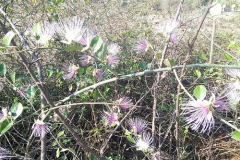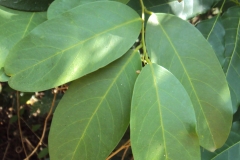Flowers & Fruits
Flowers are 2-5 in a row, which are rarely solitary, with stout pedicel and 1-2 cm long. Sepals are concave, 1 cm long and hairy while the petals are 0.9-1.6 cm long, thin, white to pinkish, with the inner side turning darker later from pinkish to red. There are 30-50 stamens with 2.5-3.5 cm long filaments. They are pink but later turn to dark purple. Flowering normally takes place from March. The gynophore measures 2.5-4.5 cm and hairy only towards the base. Fertile flowers are followed by berry that is globular to ellipsoid and measures up to 3-4 cm in diameter. Skin is woody-coriaceous. Fruits are initially green turning to red to purple as they mature. Fruits consist of numerous seeds that are globase embedded in fleshy pulp
- In the Philippines the leaves are used as a counter-irritant.
- Leaves (rubbed with salt and sometimes pounded) are used on the forehead and/or the temples as a remedy for headache.
- In Indo-China the plant is used for the same stimulant properties as the Cruciferae, also used as an antiscorbutic and for gastritis.
- Young fruits are used to cure stomach ache.
- In folk medicine, leaves used as cataplasm for boils, swelling and hemorrhoids.
- Decoction of root-bark is used for vomiting and for improving the appetite.
- Leaves also used to improve the appetite.
- Leaves are made into a poultice for treating boils, swellings and hemorrhoids.
- They are also used to reduce perspiration and to improve the appetite.
- Decoction of the root-bark is used as a remedy for vomiting and to improve the appetite.
- Root bark is ground with water, boiled and taken orally to treat indigestion.
- Traditionally it is used as Antidote to snake bite, to cure swelling of testicle, small pox, boils, cholera, colic, hemiplegia, neuralgia, sores, pneumonic & pleurisy.
- Leaves are widely used as counter-irritant, febrifuge and as a cataplasm in swellings, boil and piles in Northern India.
- Leaf and stem parts are as spasmolyte.
- Root bark preparation is used as a sedative.
- Leaves extract with black pepper powder is taken twice daily for the treatment of dysentery.
- Leaves juice taken orally with cup of fresh gout milk for curing cough and cold.
- For the treatment of diabetes ripe fruits are consumed twice for fortnight and during ingestion, stem bark extract is administered thrice daily.
- Plant is also served as an appetizer prepared as a dipping paste with pepper, tamarind and garlic.
- Grind the stem bark by adding 10 seeds of black pepper, 2 bulbs of garlic and mix it into 500 ml water. It is given twice daily for two days to cure colic.
- Handful fresh roots, 50 g onions, 50 g Jaggery grind all together and make a bolus. Take it twice daily for 3 days to cure convulsive seizures.
- Bark along with native spirit is given in Cholera.
- In madras, decoction of leaves is used in Syphilis.
- Root and bark pastes are applied together for rheumatic swellings.
Culinary Uses
- It was first time reported used as vegetable.
- Seeds of the ripe fruits are eaten roasted.
- Fruit pulps edible and can be pickled.
References:
http://www.theplantlist.org/tpl1.1/record/kew-2697723
https://indiabiodiversity.org/species/show/32086
https://en.wikipedia.org/wiki/Capparis_zeylanica
https://www.flowersofindia.net/catalog/slides/Ceylon%20Caper.html
http://tropical.theferns.info/viewtropical.php?id=Capparis+zeylanica
https://uses.plantnet-project.org/en/Capparis_zeylanica_(PROSEA)
https://wikivisually.com/wiki/Capparis_zeylanica
Comments
comments
| Ceylon caper Quick Facts | |
|---|---|
| Name: | Ceylon caper |
| Scientific Name: | Capparis zeylanica |
| Origin | India to Indo-China, Peninsular Malaysia, Indonesia (Java, Sulawesi, Lesser Sunda Islands), and the Philippines |
| Colors | Initially green turning to red to purple as they mature |
| Shapes | Berry, globular to ellipsoid and measures up to 3-4 cm in diameter |
| Taste | Bitter, pungent |
| Health benefits | Beneficial for boils, swelling, hemorrhoids, improve appetite, indigestion, small pox, boils, cholera, colic, hemiplagia, neuralgia, sores, pneumonic & pleurisy |









